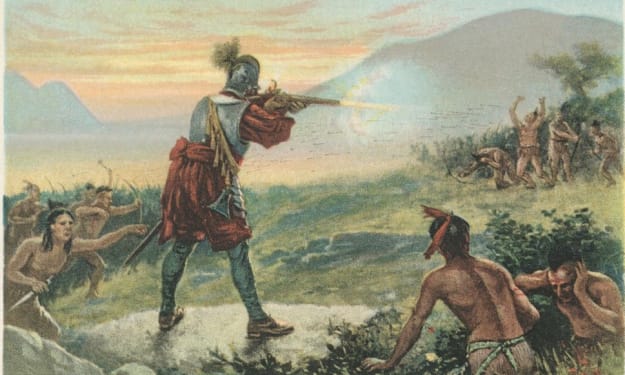The Great Leap Forward:(Part 2)
How the Introduction of French and Dutch Metal Products Transformed the American Northeast

This is the second part in an experimental history series. You can read PART 1 here. Rather than publishing my history paper as one large piece, I am breaking it up into a few smaller parts. I would love some feed back on my social media of which is better. Thank you, and enjoy.
____________________________________________________
While it took about four centuries from the introduction of gunpowder into Europe for Europeans to master its use, it would only take two decades for the arms race between the northern tribes to upend the prevailing pre-contact power structure. This was assisted by one of the main of drawbacks of firearms having been solved. The flintlock mechanism had been introduced, eliminating the matchlock, just before the French had founded New France. (3,4) Thus, no matter from whom the natives got their weapons, they came with the latest technology available at the time. Despite this, the arquebuses and muskets of the time were often more effective psychologically, rather than rapidly deployable super weapons. But they did quickly make an impression, as Samuel de Champlain noted in his journal, “The Iroquois were astonished at the noise of our muskets, and especially that the balls penetrated better than their arrows.” (5) Champlain goes into great detail in his logs about his time amongst the Huron, Montagnais, and Algonquin tribes. At times he is impressed with tribes on all sides with their skill as warriors. At other times he can be condescending, such as in this entry,
The Iroquois were much astonished that two men had been so quickly killed, although they were provided with armor woven from cotton thread and from wood, proof against their arrows. This alarmed them greatly. As I was loading again, one of my companions fired a shot from the woods, which astonished them again to such a degree that, seeing their chief dead, they lost courage, took to flight and abandoned the field and their fort, fleeing into the depths of the woods. (6)
Although one of the first records of Indian and French cooperation in battle, it would not be the last. And with the rapid growth in demand for furs and other Native American goods in the colonies and Europe, the interdependence of both groups would grow precipitously.
One of the main drivers of the arms race was the high trade value of various pelts that the tribes traded to Europeans. Many of the tribes further into the interior were late comers to the fur trade. Up until the early seventeenth century, the majority of tribes involved with the fur trade were coastal tribes. The Huron were some of the few exceptions to this. With their homeland lying along the what is now known as the Great Lakes. The Great Lakes connect to the Saint Lawrence river valley, its self-connecting to the ocean, allowed the French explorers to follow the river and its tributaries into the interior. This contact with the French quickly spread great wealth amongst the Huron Confederacy. The most lucrative furs the Native Americans would hunt for were beaver, mink, and otter. The French learned that what the northeast was lacking in real gold, the furs they could buy with an old gun or a few trinkets were far more valuable. And the trade was just as lucrative for the allies of the French. For, with their new-found wealth they could acquire lead, metal hatchets, knives, needles, awls, scissors, kettles, and traps. It was through this trade they gained ready-made clothes, blankets, and most important, their guns and powder. (7)
This near exclusive relationship between the Huron and the French led to the economic and militaristic disadvantage of the Huron’s main regional rivals, the Iroquois League. The Huron raider’s ability to penetrate the Iroquois territory due to their European supplied metal missiles cannot be understated. (8) This was due to the fundamental nature of warfare to the social status of the northeastern tribes. It was through war that young men gained their status and authority, with their status being built on their demonstration of guile and valor. Native American warfare was largely built on resources and the access to them. In this, the territorial lines were being drawn and redrawn at a near constant rate. In addition to the direct gain of resources from taking over new territory, the tribute system that followed contributed to the concentration of wealth amongst leading tribes. (9, 10)
The other main function of warfare amongst the northeastern tribes was that of the Mourning War tradition. This was a tradition whereby the winning tribe took the captives they had gained in the proceeding war and incorporate them into their own tribe. With the introduction of firearms and European diseases, this became increasingly difficult. According to historian Daniel K. Richter, “In a successful raid, men of the Five Nations could not only seize the captives their mourning kinswomen demanded, but they could also pillage valuable trade goods.” (11, 12) But as the scourge of disease and viral expansion of Europeans deeper into native society, the need to resupply tribes on all sides swelled with each successive campaign. Thus, the tribes of the Great Lakes region began to move into areas they had not previously occupied.
The founding of Fort Orange by the Dutch in 1614, injected a new level of competition into the region for both Europeans and natives alike. The Iroquois now had direct trading partners to supply them in their campaign against the Huron. The Dutch being newcomers to both colonization and their own independence were quick to scorn the idea of limiting arms sells to the local tribes. And to that end, the tribes of the Iroquois League were more than willing to take advantage.
With the influx arms supplied by the Dutch, the Iroquois quickly regained their status as the near-peer competitors of the Huron and went on the offensive. On March 16, 1649 the Iroquois initiated a predawn attack on the Christianized Huron settlement of Saint Ignace. Historian Keith F. Otterbein notes an earlier account in his writing that, “‘The Iroquois …to the number of about a thousand men, well furnished with weapons, - and mostly with firearms…. Arrived by night as the frontier of this country, without having any knowledge of their approach…’” (13) This raid is an example of the combination of traditional Iroquois tactics and techniques combined with European technology. In the battle, the raiders caught the Huron off-guard and were able to overwhelm the Huron defenders. The battle is also noted for the Huron’s inability to organize a counterattack on the first day, and to take advantage of the counterattack they managed to gain on the second. The reason behind the lack of countering on the first day was the Huron village’s inability to withstand assaults by large armies, their poor communication between villages, and the nonexistent practice of a quick reaction force that could come to the aid of attacked villages. Their poor organization further amplified by the lack of initiative led to the squandering of the offensive on the second day, leading to an Iroquois victory on the third.
The Great Leap Forward:(Part 3)
Thank you for reading my work. If you enjoyed this story, there’s more below. Please hit the like and subscribe button, you can follow me on Twitter @AtomicHistorian, and if you want to help me create more content, please consider leaving a tip or a pledged subscriber.
More from this author:
Citations:
3. Ibid., 49.
4. Ibid., 52.
5. William Lawson Grant, ed., Samuel De Champlain, Voyages of Samuel de Champlain The Voyages and Expeditions of Samuel de Champlain (1604-1616) (New York: New York, 1907), 181.
6. Paul W. Mapp, Brett Rushforth, Colonial North America and the Atlantic World (Upper Saddle River: New Jersey, 2009),79
7. Jeffrey P. Blick, The Iroquois Practice of genocidal warfare (1534-1787), Journal of Genocide Research, (Sydney: Australia, 2001), 412.
8. Jeffrey P. Blick, The Iroquois Practice of genocidal warfare (1534-1787), Journal of Genocide Research, (Sydney: Australia, 2001), 412.
9. Wayne E. Lee, Peace Chiefs and Blood Revenge: Patterns of Restraint in Native American Warfare, 1500-1800, The Journal of Military History, (July 2007), 701.
10. Ibid., 702.
11. Daniel K. Richter, James H. Merrell, ed. Beyond the Covenant Chain: The Iroquois and Their Neighbors in Indian North America, 1600-1800 (Syracuse: Syracuse University Press. 1987), 19.
12. Ibid., 20.
13. Keith F. Otterbein, Huron vs Iroquois: A Case Study in Inter-Tribal Warfare, Ethnohistory Volume 26, Number 2 (Spring 1979), 143.






Comments (1)
Still very interesting.